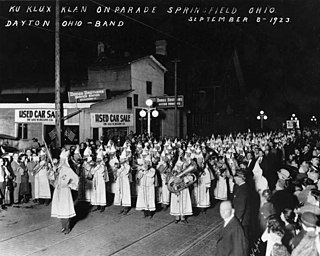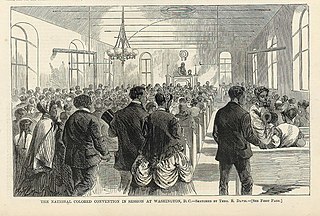History
Background
In the pre-Civil War era, many free black workers in the United States faced economic competition from both native-born white Americans and European immigrants, including Irish Americans. [1] Additionally, African Americans were barred access to many labor unions, which only admitted white members. [1] [2] As a result of this, many African Americans formed mutual organizations and benevolent societies in order to assist each other economically. [1] [3] [4] [2] Examples of these organizations include the Coachman's Benevolent Society (established 1825) and the Humane Mechanics (1828) in Philadelphia, the Baltimore Caulker's Association (1838) in Baltimore, and the Colored Sailor's Home (1839) in New York City. [5] According to historian Gerald D. Jaynes in the Encyclopedia of African American Society, these organizations can be considered "forerunners" or "predecessors" to labor unions, [6] while labor historian Philip S. Foner stated that these groups "resembled fraternal lodges more than trade unions". [3]
Formation

On June 13, 1850, [7] in response to the difficulties faced by African Americans in joining existing labor unions and as part of a wave of efforts towards black economic self-sufficiency and cooperation, [8] [9] several noted social reformers and black activists met at the Mother African Methodist Episcopal Zion Church at the intersection of Leonard Street and Church Street to establish the American League of Colored Laborers (ALCL). [7] The national organization would represent free African Americans who were employed in skilled trades, [7] [10] such as mechanics, [11] and it is considered by historian Lerone Bennett Jr. to be the first labor union established for black people in American history. [note 1] Social reformer Frederick Douglass was instrumental in establishing the organization, [7] [9] [15] alongside other noted reformers and activists of the era, such as George T. Downing, [16] Charles Bennett Ray, [17] Charles L. Reason, [18] James McCune Smith, [19] and Samuel Ringgold Ward. [8] At the initial meeting, officers for the new group were selected, with Ward as president, Douglass as vice president (a position he shared with Lewis Woodson), [20] and Henry Bibb as secretary. [7] Additionally, an executive committee of 23 members was selected, [21] with plans for this group to meet monthly to discuss league business. [11] Douglass's involvement with the organization, as well as the participation of several editors from African American newspapers, helped the union to garner fairly widespread coverage in the black press. [7]
Goals
Despite being a labor union, the league had goals that differentiated it from more traditional organized labor groups. [22] In addition to its goal of promoting unity and cooperation among black mechanics and tradespeople, [1] [23] the union placed a great deal of emphasis on promoting more educational opportunities within the African American community, primarily in the fields of agriculture and industry. [1] [19] [23] Douglass and Ward also envisioned that the league would eventually serve as a loan-giving organization for African American entrepreneurs, [8] and starting with their initial meeting, the union announced plans to establish funds to provide money for people trying to open their own businesses. [7] [24] At an 1851 meeting, the union proposed the establishment of a mutual savings bank. [22] [7] Additionally, the union planned to hold an industrial fair in May 1852 to showcase black industry, with the proceeds from the fair being split between the tradespeople and the union. [24] [7] [note 2] These goals have led several historians to question how to properly categorize the league. [note 3]
Demise
Ultimately, the planned 1852 industrial fair never took place. [7] [25] Ultimately, the ALCL was a short-lived organization, [8] with historian John Ernest writing in 2011 that the league disbanded shortly after its initial meeting and historian Stuart McElderry saying it "ceased to exist during the later half of the 1800s". [5] [22] Multiple reasons have been given for the league's downfall, with many historians noting that one of the largest issues facing the union was the small number of black artisans working in cities at the time. [7] [22] The league additionally suffered from the growth of white-only craft unions and increased European immigration that stifled the development of black industry, [7] and McElderry additionally cites "poor leadership and internal disputes" within the organization. [22] Historian Leslie M. Harris wrote in 2003 regarding the union, "The group united reformers who held varying views regarding ways to assist black workers, but does not seem to have attracted any workers". [25] Ultimately, the union's demise was typical for black economic cooperative organizations of the era, as almost all such groups during this time were short-lived. [26] [27] Multiple historians have noted that the league's demise could be viewed as indicative of a growing class divide between the workers and the social reformers in the African American community during this time. [28] [29]
Later African American unionization efforts
In the years following the ALCL's demise, unionization efforts continued among African Americans, in particular among longshoremen in port cities such as Charleston, South Carolina, and New Orleans. [12] In 1869, the Knights of Labor became the first white union to allow black people to join, though the union offered little support to its black members, as demonstrated in the events leading up to the Thibodaux massacre. [6] Also in 1869, black activists met in Washington, D.C., in a conference that eventually led to the creation of the Colored National Labor Union, which Bennett cites as "[t]he first major national effort" towards a black nationwide union. [12] Douglass would later serve as president of this union. [4] As of 2019, the Coalition of Black Trade Unionists represents the interests of many African American union members in over 50 different unions, with labor journalist Kim Kelly calling the group "a bridge between the labor movement and the black community". [9]










